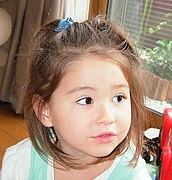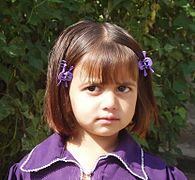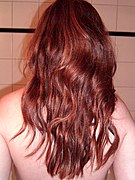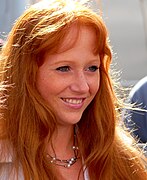Human hair color
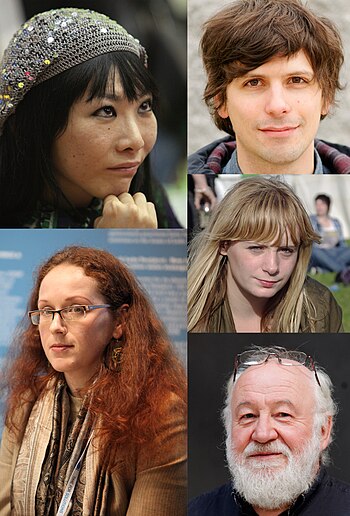
Human hair coloris the pigmentation ofhumanhair folliclesandshaftsdue to two types ofmelanin:eumelaninandpheomelanin.Generally, the more melanin present, the darker the hair. Its tone depends on the ratio of black or brown eumelanin to yellow or red pheomelanin. Melanin levels can vary over time, causing a person's hair color to change, and one person can have hair follicles of more than one color. Some hair colors are associated with someethnic groupsbecause of the observed higher frequency of particular hair colors within their geographical region, e.g. straight, dark hair amongstEast Asians,Southeast Asians,Polynesians,someCentral Asians,andNative Americans;a large variety of dark, fair, curly, straight, wavy or bushy amongstEuropeans,West Asians,some Central Asians, andNorth Africans;and curly, dark, and uniquely helical hair amongstSub Saharan Africans.Bright red hair is found in some European populations, and hair turns gray, white, or "silver" withage.
Genetics and biochemistry of hair color
[edit]

The full genetic basis of hair color is complex and not fully understood.[1]RegulatoryDNA is believed to be closely involved in pigmentation in humans in general,[2]and a 2011 study by Branicki et al. identified 13DNAvariations across 11 different genes that could be used to predict hair color.[3]
Two types of pigment give hair its color, black-browneumelaninand reddish-brown/reddish-yellow[4]pheomelanin,synthesizedbymelanocytes.[5]Inside the melanocytes,tyrosineis converted intoL-DOPAand thenL-dopaquinone,which in turn is formed into pheomelanin or eumelanin.[6]
Different hair colorphenotypesarise primarily as a result of varying ratios of these two pigments in the human population,[5]although Europeans show the greatest range in pigmentation overall.[7]In addition, other genetic and environmental factors can affect hair color in humans; for instance, mutations in themelanocortin 1 receptor(MC1R) gene can lead to red or auburn hair,[5]and exposure toultraviolet radiationcan damage hair and alter its pigmentation.[8]Ultraviolet radiation(UV radiation) triggers greater synthesis of several compounds, includingpro-opiomelanocortin(POMC),α-MSH,andACTH,the result being increased eumelanin production.[6]UV radiation most commonly comes from the sun, and thus populations from places closer to theequatortend to have darker hair,[6]because eumelanin is generally morephotoprotectivethan pheomelanin.[4]
Pheomelanin colors hairorangeandred.Eumelanin, which has two subtypes ofblackorbrown,determines the darkness of the hair color;[4]more black eumelanin leads to blacker hair and more brown eumelanin to browner hair.[6]All human hair has some amount of both pigments.[9]Over 95% of melanin content in black and brown hair is eumelanin.[9]Pheomelanin is generally found in elevated concentrations in blond and red hair,[4]representing about one-third of total melanin content.[9]If there is no black eumelanin, the result is strawberry blond.[6]Blond hair results from small amounts of brown eumelanin with no black eumelanin.[6]
Natural hair colors
[edit]| Blond | Dark blond | Medium brown | Dark brown | Black | Reddish-brown | Red | Gray | White |
Natural hair color can be black, brown, blonde and red.[10]
Color shade scale
[edit]TheFischer–Saller scale,named afterEugen Fischerand Karl Saller is used inphysical anthropologyand medicine to determine the shades of hair color. The scale uses the following designations: A (very light blond), B to E (light blond), F to L (blond), M to O (dark blond), P to T (light brown to brown), U to Y (dark brown toblack) andRoman numeralsI to IV (red) and V to VI (red-blond).[11]
Image gallery
[edit]-
Natural black hair
-
Dark brown hair
-
Medium brown hair
-
Light brown hair
-
Chestnut brown hair
-
Light chestnut brown hair
-
Orange red hair
-
Copper hair
-
Strawberry blond hair
-
Light blond hair
-
Golden blond hair
-
Medium blond hair
-
Gray hair
-
White hair
-
White hair caused byalbinism
Black hair
[edit]Black hair or jet black hair is the darkest hair color. It has large amounts of eumelanin and is denser than other hair colors and is the commonly seen hair color in Asia and Africa due the fact that the people in these regions tend to have lower levels of tyrosinase in their bodies. Black eumelanin secretion causes the hair to turn black, which indicates that the MC1R is in the active state. Jet black hair, the darkest shade will not have a warm, neutral tone but a sheen which can seem almost blue, like the iridescence of a raven's wing; hence, sometimes referred to as raven-black. Jet black hair appears to have reflective silver color in bright sunlight.[12][13]
Brown hair
[edit]
Brown hair is the second most common human hair color, after black. Brown hair is characterized by higher levels of eumelanin and lower levels of pheomelanin. Of the two types of eumelanin (black and brown), brown-haired people have brown eumelanin; they also usually have medium-thick strands of hair. Brown-haired girls or women of European, West Asian or North African descent are often known as brunettes.
Chestnut hair is a hair color which is a reddish shade of brown hair. In contrast to auburn hair, the reddish shade of chestnut is darker. Chestnut hair is common among the native peoples of Northern, Central, Western, and Eastern Europe and is also found inAsia Minor,West AsiaandNorth Africa.
Auburn hair
[edit]
Auburn hair ranges along a spectrum of light to dark red-brown shades. The chemicals which cause auburn hair areeumelanin(brown) andpheomelanin(red), with a higher proportion of red-causing pheomelanin than is found in average brown hair. It is most commonly found in individuals of Northern and Western European descent, but is extant in West and Central Asia and North Africa also. It can also be the result of a mutation in the melanocortin 1 receptor gene.[5]
Red hair
[edit]Red hair ranges from light strawberry blond shades totitian,copper, and completely red. Red hair has the highest amounts ofpheomelanin,around 67%, and usually low levels ofeumelanin.At 1–2% of the west Eurasian population, it is the least common hair color in the world. It is most prominently found in theBritish Islesand inUdmurtia.Scotland has the highest proportion of redheads; 13 percent of the population has red hair and approximately 40 percent carry the recessive redhead gene. Red hair can also occur in Southern Europe, West Asia, North Africa and Central Asia.[14][15][16]
Blond hair
[edit]Blond (sometimesblondefor women) hair ranges from pale white (platinum blond) to dark gold blond. Strawberry blond, a mixture of blond and red hair, is a much rarer type containing the mostpheomelanin.[citation needed]Blond hair can have almost any proportion of pheomelanin andeumelanin,but has only small amounts of both. More pheomelanin creates a more golden or strawberry blond color, and more eumelanin creates an ash or sandy blond color. Blond hair is most commonly found in Northern and Northeastern Europeans and their descendants but can be found spread around most of Europe and also among West Asians and North Africans at lower frequencies. Studies in 2012 showed that naturally blond hair of Melanesians is caused by a recessive mutation in tyrosinase-related protein 1 (TYRP1). In the Solomon Islands, 26% of the population carry the gene; however, it is absent outside of Oceania.[17]
Gray and white hair
[edit]Gray or white hair is not caused by a true gray or white pigment, but is due to a lack of pigmentation and melanin. The clear hairs appear as gray or white because of the way light is reflected from the hairs. Gray hair color typically occurs naturally as peopleage(seeaging or achromotrichiabelow).
Marie Antoinette syndromeis a proposed phenomenon in which sudden whitening is caused by stress. It has been found that some hairs can become colored again when stress is reduced.[18][19]
Conditions affecting hair color
[edit]
Aging or achromotrichia
[edit]Children born with some hair colors may find it gradually darkens as they grow. Many blond, light brown, or red haired infants experience this. This is caused by genes being turned on and off during early childhood and puberty.[20]
Changes in hair color typically occur naturally as people age, eventually turning the hair gray and then white. This is called achromotrichia. Achromotrichia normally begins in the early to mid-twenties in men and late twenties in women. More than 60 percent of Americans have some gray hair by age 40. The age at which graying begins seems almost entirely due togenetics.Sometimes people are born with gray hair because they inherit the trait.[21]
The order in which graying happens is usually: nose hair, hair on the head, beard, body hair, eyebrows.[22]
Hair coloring
[edit]
Hair color can be changed by a chemical process. Hair coloring is classed as "permanent" or "semi-permanent".
Permanent hair color means that the hair's structure has been chemically altered until it is eventually cut away. This does not mean that the synthetic color will remain permanently. During the process, the natural color is removed, one or more shades, and synthetic color has been put in its place. All pigments wash out of the cuticle. Natural color stays in much longer and artificial will fade the fastest (depending on the color molecules and the form of the dye pigments).
Permanent hair color gives the most flexibility because it can make hair lighter or darker as well as changing tone and color, but there are negatives. Constant (monthly or six-weekly) maintenance is essential to match new hair growing in to the rest of the hair, and to remedy fading. A one-color permanent dye creates a flat, uniform color across the whole head, which can look unnatural and harsh, especially in a fair shade. To combat this, the modern trend is to use multiple colors—usually one color as a base with added highlights or lowlights in other shades.
Semi-permanent color washes out over a period of time—typically four to six weeks, so root regrowth is less noticeable. The final color of each strand is affected by its original color and porosity, so there will be subtle variations in color across the head—more natural and less harsh than a permanent dye. However, this means that gray and white hair will not dye to the same color as the rest of the head (in fact, some white hair will not absorb the color at all). A few gray and white hairs will blend in visually, but semi-permanent dye alone will not usually give the desired result where there is a lot of gray or white hair present. Sometimes a mixture of dyes is used while hair is greying: semi-permanent as a base color, with permanent highlights.
Semi-permanent hair color cannot lighten hair.[23]Hair can only be lightened using chemical lighteners, such as bleach. Bleaching is always permanent because it removes the natural pigment.
"Rinses" are a form of temporary hair color, usually applied to hair during a shampoo and washed out again the next time the hair is washed.
See also
[edit]References
[edit]- ^Genetics Home Reference."Is hair color determined by genetics?".US National Library of Medicine.RetrievedMay 10,2020.
- ^Pennisi, Elizabeth(June 1, 2014)."The Genetics of Blond Hair".Science Magazine.RetrievedMay 10,2020.
- ^Branicki, Wojciech; Liu, Fan; van Duijn, Kate; Draus-Barini, Jolanta; Pośpiech, Ewelina; Walsh, Susan; Kupiec, Tomasz; Wojas-Pelc, Anna; Kayser, Manfred (January 4, 2011)."Model-based prediction of human hair color using DNA variants".Human Genetics.129(4): 443–454.doi:10.1007/s00439-010-0939-8.PMC3057002.PMID21197618.
- ^abcdFarthmann, B.; Schmitz, S.; Krasagakis, K.; Orfanos, C. E. (1997). "Photoprotection by Total Melanin Content and Pigment Phenotype (Eumelanin, Pheomelanin) in Human Melanoma Cell Lines".Skin Cancer and UV Radiation.pp. 181–185.doi:10.1007/978-3-642-60771-4_21.ISBN978-3-642-64547-1.
- ^abcdKumar, Anagha Bangalore; Shamim, Huma; Nagaraju, Umashankar (2018)."Premature graying of hair: Review with updates".International Journal of Trichology.10(5): 198–203.doi:10.4103/ijt.ijt_47_18.PMC6290285.PMID30607038.
- ^abcdefSchlessinger, Daniel I.; Schlessinger, Joel (January 2020).Biochemistry, Melanin.StatPearls Publishing.PMID29083759.RetrievedMay 22,2020.
- ^Sturm, R. A. (April 15, 2009)."Molecular genetics of human pigmentation diversity".Human Molecular Genetics.18(R1): R9–R17.doi:10.1093/hmg/ddp003.PMID19297406.
- ^Santos Nogueira, Ana Carolina; Joekes, Ines (May 2004). "Hair color changes and protein damage caused by ultraviolet radiation".Journal of Photochemistry and Photobiology B: Biology.74(2–3): 109–117.doi:10.1016/j.jphotobiol.2004.03.001.PMID15157906.
- ^abcRobbins, Clarence R. (2012).Chemical and Physical Behavior of Human Hair.Springer. pp. 315–17.ISBN9783642256103.RetrievedMay 22,2020.
- ^"Is hair color determined by genetics?: MedlinePlus Genetics".medlineplus.gov.RetrievedApril 12,2023.
- ^"Change in Hair Pigmentation in Children from Birth to 5 Years in a European Population (Longitudinal Study)".Forensic Science Communications. Archived fromthe originalon March 20, 2014.RetrievedMarch 19,2014.
- ^Ito, S.; Wakamatsu, K. (2011). "Diversity of human hair pigmentation as studied by chemical analysis of eumelanin and pheomelanin".Journal of the European Academy of Dermatology and Venereology.25(12): 1369–1380.doi:10.1111/j.1468-3083.2011.04278.x.PMID22077870.S2CID5121042.
- ^"Genetics of Hair Color".Medical News.December 29, 2022.
- ^"Scientists question whether rare reds are headed for extinction".Azcentral.com. May 5, 2005. Archived fromthe originalon May 11, 2023.RetrievedApril 3,2012.
- ^"The Genetics of Red Hair: What Causes Natural Red Hair?".Brighthub.com. September 4, 2009.RetrievedApril 3,2012.
- ^"Michigan twins featured in book about rare red hair".MLive.com. November 3, 2009.RetrievedApril 3,2012.
- ^Melanesian blond hair is caused by an amino acid change in TYRP1.Kenny EE, Timpson NJ, Sikora M, Yee MC, Moreno-Estrada A, Eng C, Huntsman S, Burchard EG, Stoneking M, Bustamante CD, Myles S (May 2012)."Melanesian blond hair is caused by an amino acid change in TYRP1".Science.336(6081): 554.Bibcode:2012Sci...336..554K.doi:10.1126/science.1217849.PMC3481182.PMID22556244.
- ^Alice Klein (June 6, 2020)."Grey hairs sometimes regain their colour when we feel less stressed".New Scientist.
- ^Ayelet Rosenberg; et al. (May 19, 2020)."Human Hair Graying is Naturally Reversible and Linked to Stress".bioRxiv.doi:10.1101/2020.05.18.101964.S2CID218764733.
- ^"Understanding Genetics: Human Health and the Genome".Archived fromthe originalon July 24, 2011.RetrievedJuly 25,2011.
- ^Pandhi, D; Khanna, D (2013)."Premature graying of hair".Indian Journal of Dermatology, Venereology and Leprology.79(5): 641–53.doi:10.4103/0378-6323.116733.PMID23974581.
- ^Tị mao にも bạch phát は sinh えるの?(in Japanese).RetrievedJuly 3,2012.
- ^Aguh, Crystal; Okoye, Ginette (December 6, 2016).Fundamentals of Ethnic Hair: The Dermatologist's Perspective.Springer.ISBN9783319456959.




